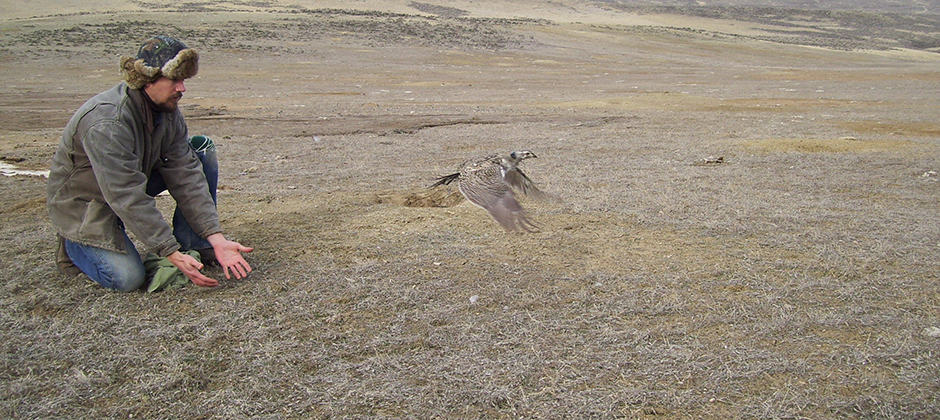Share this article
JWM: Energy development impacts sage-grouse reproduction
Energy development throughout Wyoming — including wind turbines and natural gas and oil extraction — decreases greater sage-grouse reproduction by removing the sagebrush landscapes they rely on, according to a recent study published in the Journal of Wildlife Management.
Previous studies had looked at individual types of energy development in specific areas, said TWS member Chris Kirol, who conducted the research as a research associate at the University of Wyoming, and is now a PhD candidate in the Fedy lab at the University of Waterloo in Ontario. He wanted to take a broader look at energy development throughout the bird’s range.
“It’s a really big issue in the West,” Kirol said, “because sage-grouse in a lot of places are in decline and not thriving, and on top of that there are these impacts of energy development.”
In the study, Kirol looked at the effects of all types of energy development on greater sage-grouse (Centrocercus urophasianus) in Wyoming over seven years. “We wanted to look at a population level response to the actual footprint of development, regardless of the type of development, on reproduction,” he said.
Kirol and his colleagues looked at nesting and brood rearing responses to energy development by fitting transmitters on sage-grouse to monitor nest sites and see if they had successfully raised chicks. Forty days after the chicks hatched, they used spotlights at night to see if the chicks were still alive. “Previous research showed that if sage-grouse chicks lived through 40 days, they’re more likely to live through the winter,” he said.
Kirol and his team found that nest survival decreased as disturbance increased within 8 square kilometers of a nest. Females were more likely to lose their chicks if exposed to energy disturbance within 1 square kilometer. “They were more likely to get depredated along the way than if she was out in a non-disturbed habitat,” he said.
While greater sage-grouse reproduction proved to be impacted by development, the team found that female sage-grouse actively selected areas where there was less disturbance when that was available to them. In 90% of nest and brood-rearing locations, they found 3% or less of the surrounding sagebrush habita twas disturbed. Currently, in core sage-grouse areas in Wyoming, managers are using a disturbance cap of 5% for sage-grouse habitat.
The sage-grouse “are recognizing in some way these consequences,” Kirol said, “and they’re moving out of these areas or moving away from higher disturbance areas.” That’s good news, he said, but it means undisturbed habitats will need to be available to them.
This article features research that was published in a TWS peer-reviewed journal. Individual online access to all TWS journal articles is a benefit of membership. Join TWS now to read the latest in wildlife research.
Header Image: Study co-author Andrew Sutphin releases a tagged female greater sage-grouse. ©Thomas Maechtle








